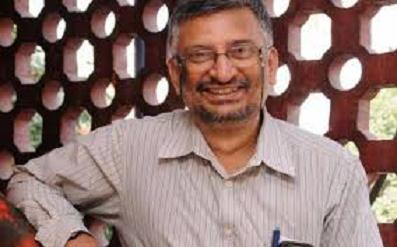Way back in 1971, a furious cyclone struck India’s east coast. It caused widespread devastation in coastal villages in Odisha. Life came to a standstill in many villages. In one such remote hamlet, there was large scale destruction – trees got uprooted, houses damaged and crops were ravaged. This left a lasting impression on the mind of a six-year old boy in the village. His father was a conscientious community member. He went around the village, herding people to safety of a few pucca houses. For more than a year, the boy and his family – and rest of the village – had to go without their staple food – rice – as all the crops had been lost. They all had to depend on wheat supplied as a relief material. Astonished by the nature’s fury, the young resolved that one day he would ‘tame’ cyclones and save lives. And when he grew up, he did exactly the same thing.
This, in nutshell, is the story of Dr. Mrutyunjay Mohapatra, who is affectionately known as ‘cyclone man of India’ for having accurately predicted the path of ferocious cyclonic storm Phailin that hit the coast of Orissa in 1999. Accurate prediction and timely action by local authorities and people saved tens of thousands of lives and it was greatly appreciated by national and international agencies. As head of the cyclone division in the Indian Meteorological Department, New Delhi, Mohapatra has seen over forty cyclones. He says, “my responsibility is to motivate colleagues and try to minimize loss of life and property.”
Cyclones are characterized by inward spiraling winds that rotate about a zone of low pressure. Word 'cyclone' is derived from Greek 'Cyclos' where 'Cyclos' means the coil of a snake. The word was coined by Heary Piddington who worked as a rapporteur in Kolkata during the British rule. A tropical cyclone is a rotational low pressure system in tropics when the central pressure falls from the surrounding and maximum sustained wind speed reached about 62 km per hour. It is a vast violent whirl spiraling around a centre and progressing along the sea surface.
Unlike astronomical phenomena like full moon or even complicated events such as eclipses, Mohapatra says “weather phenomena are non-linear.” He says “imagine you draw a straight line of four centimeters and again continue from the end point for another four cm, you can know easily the total is eight cm this is linear; but now imagine a curve whose length is four cm and now you draw another curve of length from the end point of the first, you can’t predict the length from the starting point to the end point. This is non-linear”. Whether phenomena like cyclones are greatly influenced by initial conditions and hence knowing as accurately possible the initial condition helps in more reasonable predictions.
Cyclone Man of India: Dr Mrutyunjay Mohapatra
Mohapatra says we can now “predict five days in advance the area of occurrence, time and point of landfall, wind velocity and wave height.”
Modern-day meteorologists deploy satellites, radars, scatterometers and supercomputers to gather data and identify formation of cyclones, predict their paths and landfall points. The magnitude and direction of the wind vector at the ocean surface is a key parameter for weather prediction, detection and tracking of cyclones. Global wind data, which is very crucial for cyclone detection and weather forecasting applications, are gathered by scatterometer instrument flown as one of the payloads in OCEANSAT- 2 satellite. With high-power computing systems available with IMD, three weather satellites and a string of Doppler radars along the coast, Mohapatra says we can now “predict five days in advance the area of occurrence, time and point of landfall, wind velocity and wave height.” With accurate and timely prediction it is possible for civil authorities to evacuate people in potential risk areas and reduce greatly human losses associated with cyclones.
Mohapatra joined IMD in 1992 and was working in Odisha when the Super Cyclone of 1999 struck the coast killing more than 15,000 people. At that time, only 24-hour prediction warning was available and that surely was not sufficient to save lives. He and others could do nothing as the cyclone ravaged. As a fallout of this human tragedy, IMD embarked upon modernization of the weather prediction with a view to predict natural disasters such as cyclones and tsunami in advance and provide accurate reliable advance information to civil authorities to undertake precautionary actions. Mohapatra was shifted to Delhi in 2002 and asked to oversee the modernization.
Today three state-of-art Indian satellites constantly watch over the Indian region and provide weather picture every fifteen minutes. Twenty four Doppler radars have been already installed constantly watching for the formation of low pressure area in the Arabian sea and Bay of Bengal. Six thousand seventy five automatic weather augmented by five hundred fifty manned stations, twenty ocean buoys assist effective cyclone prediction.
Braced up, when Cyclone Phailin struck eastern coast of India in 2013, Dr Mohapatra and his team was able to predict the point of landfall, wind velocity and wave height. With timely and accurate inputs from IMD, civil authorities evacuated one million people before the cyclone stuck the coast. Due to early and timely action, just twenty lives are lost and tens and thousands of lives are saved. Effective early warnings of cyclone Phailin, Hudhud and Vardha by his team have saved many lives. He has pasted large size pictures of the cyclone devastation in various parts of the country in cyclone division and says “we want to remember, our timely and conscientious action will make a difference between life and death; devastation and preservation of assets.”
About Rs 500 crores were invested in the modernization which is less than the ex-gratia payment made by the government during the Orissa super cyclone. The lives and damages saved in just one cyclone go to meet the government investment. He says “it pays to invest in science; it saves money and lives” A Ph D in Physics, Mohapatra has received many national and international awards including the Young Scientist Award of Ministry of Earth Sciences and Achievers Award from the IMD for his research and service in the field of atmospheric sciences. (India Science Wire)

